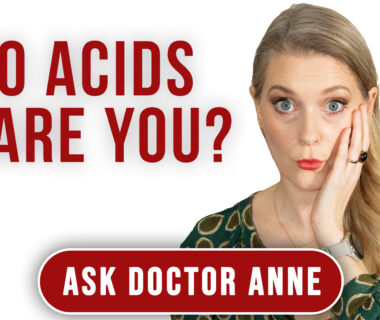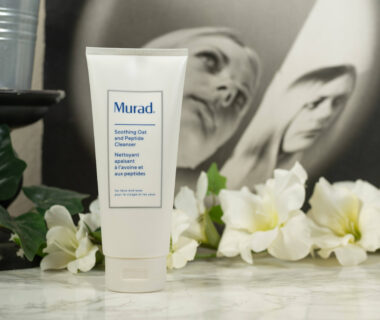ADVERTISEMENT INFO: LINKS USED ARE AFFILIATE LINKS. I RECEIVED NO MONEY TO WRITE THE BLOGPOST. PLEASE READ DISCLAIMER
How do I get rid of my perioral dermatitis? Can you recommend skincare products for perioral dermatitis? Can you take a look at that stubborn rash around my mouth that just doesn’t seem to go away? I get quite a few of these questions, so today let’s take a closer look at perioral dermatitis!

What is it? Why do you get it? And most importantly: How do you get rid of it?
What is perioral dermatitis?
Perioral dermatitis is a dermatitis, meaning a skin inflammation, around the mouth or peri – around oral – the mouth. The better term is periorificial dermatitis, with periorificial meaning peri – around orificial – the openings as it can also occur around the nose and the eyes. Around the mouth is the most common location though.
While it can appear in both sexes and during all phases of life, roughly 90% of cases are women around the age of 20 to 45.
It can manifest in different forms: Sometimes there is just redness and sensitivity around the mouth, sometimes the skin gets dry and flaky, but quite commonly there are papules and pustules, so either red bumps or red bumps with pus on top that can look similar to acne or rosacea. (More info: Everything you need to know about rosacea)
Almost always there is a halo, meaning the skin closest to the lips, the vermillion border, is not affected, so you have a few millimeters of normal skin and then the redness starts.
While a burning or stinging sensation is quite common, it is usually not very painful and with a few exceptions appears on both sides of the mouth, not just on one.
It can also fluctuate in intensity over time.
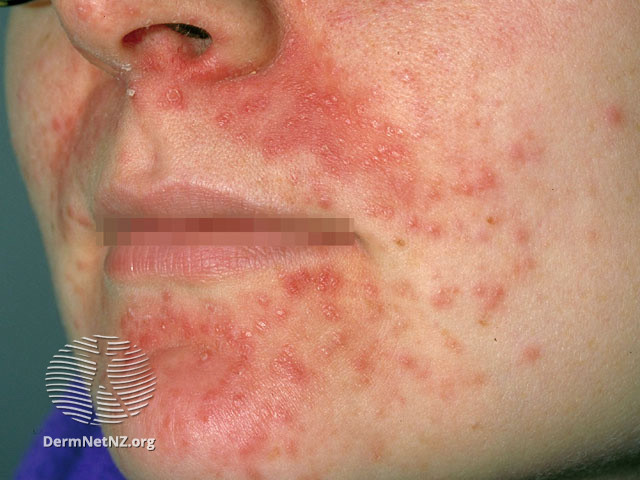
How do I know I have perioral dermatitis?
The different appearances it has make it difficult to self-diagnose if you suffer from perioral dermatitis or another skin rash. It can be mistaken for contact dermatitis, seborrheic dermatitis, acne, rosacea or just plain eczema, so I strongly recommend seeing a healthcare provider, ideally a dermatologist, for the diagnosis and the necessary treatment.
But whenever you suffer from a rash or acne outbreak that doesn’t seem to respond to an acne routine or that first disappears when treated with a topical steroid only to reappear more intensely after you stopped, perioral dermatitis is something you need to think about.
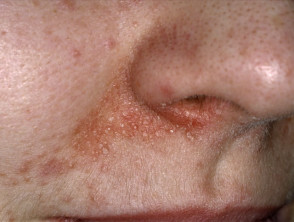
Source: DermNetNZ
What causes perioral dermatitis?
Sadly it isn’t entirely known what triggers perioral dermatitis – we have identified risk factors and common causes, but not everyone exposed develops it and not everyone that has it was exposed to the same triggers. In some cases we never manage to find out why someone is suffering from that condition, which can be frustrating.
Quite often though you will develop perioral dermatitis after a period of using topical or inhaled corticosteroids, either because you suffer from asthma and need them for treatment or because you had a small rash or inflammation and decided to get a Hydrocortisone Cream to get rid of it. The rash goes away, but once you stop the cream, perioral dermatitis appears, and if you decide to treat that again with a topical steroid, you’ll enter a cycle in which after each treatment course that brings temporary relief, the problem comes back even worse.
Another common trigger seems to be fluoridated toothpaste, mint and cinnamon flavors either in your dental or in lip products and in general the use of cosmetics. Cosmetics is a very broad term that includes basically all skincare and makeup, and sadly it can’t be narrowed down much more. One study showed that the more products you combined, the higher your risk got – again though not everyone using ten steps got perioral dermatitis and at the same time people using only two products could suffer from it, there is no direct link as in: When you use more than 5 steps, you will get it for sure!
Broadly speaking the risk seems to be the highest when the products are very occlusive, think ointments and Petroleum Jelly or when the products are irritating, so basically any active you apply and the use of Isopropyl Myristate as vehicle. In children it is connected to the use of mineral or anorganic sunscreen.
Given that the majority of cases are in women of reproductive age and that it can worsen right before you get your period and is influenced by birth control pills, a hormonal influence is likely, but not yet fully understood – going on birth control can both lighten and worsen the symptoms.
As it is with all inflammatory diseases, stress has an influence as well, both environmental stress as in harsh weather conditions and internal stress, think the stress of having to socialize with a red bumpy rash in the middle of your face…
The newest identified trigger is wearing a well-fitted face mask for prolonged periods of time, think healthcare workers during the pandemic. The humidity trapped underneath leads to skin barrier changes and can increase your risk to develop perioral dermatitis. You will need to wear the mask for a long time without break though, so putting it on before you use public transport or do the groceries is still fine – and something I recommend to protect yourself and your loved ones!
Just to be clear: None of the things I talked about like occlusives, actives, makeup or fluoridated toothpaste are “bad” – all of them play an important role, you’ll need the Fluoride to prevent cavities for example. It is just that in this specific case, you as an individual might not react well to them. If you don’t have any issues, don’t cut them out just “to be sure”.
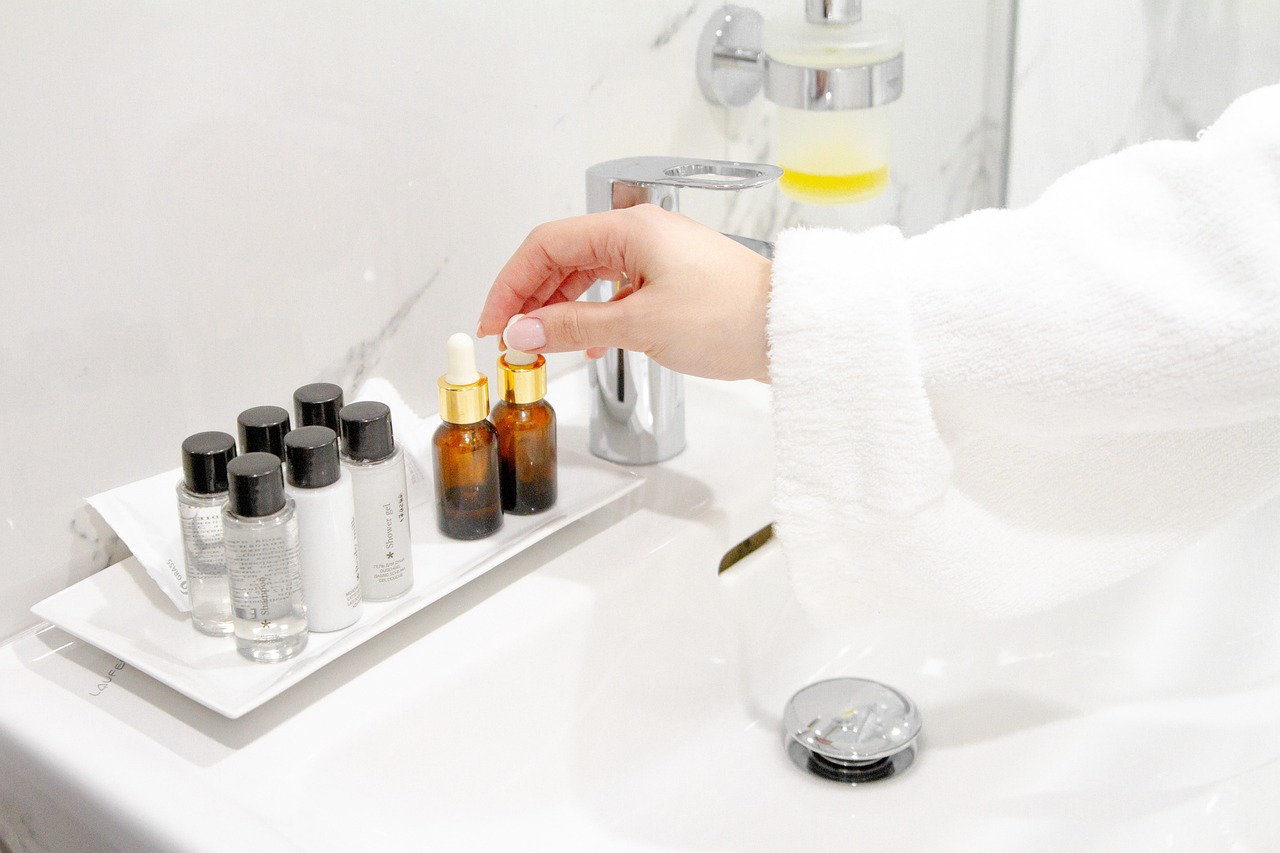
Image by olga volkovitskaia from Pixabay
What can I do at home if I suspect I have perioral dermatitis?
Whenever possible, try to get a diagnosis from a health care provider to make sure it is really perioral dermatitis and not something like rosacea, eczema or a skin infection.
Then, and I know what I am asking here, stop using skincare and makeup, if possible including sunscreen. (I just died a little saying that.) Wash your face with tepid water, use a plain, but non-occlusive moisturizer if you absolutely need to and leave it at that. (More info: The 5 steps you need to take if your skin barrier is damaged)
Stop using fluoridated toothpaste, mint or cinnamon flavored dental products, breath mints or cosmetics and if possible, stop using corticosteroids on and around your face. That of course absolutely NOT includes your prescription inhalers and such, always talk to your prescribing doctor before you make any changes there!
And then have patience and try to get an appointment.
How can I cure my perioral dermatitis?
While perioral dermatitis can go away on its own once you have stopped the triggers, it usually takes weeks to months until this happens. Your healthcare provider will be able to offer topical antibiotics, Azelaic Acid or antiinflammatory medication like Pimecrolimus, which is a Calcineurin-Inhibitor that often shorten the time until remission, but still can take up to three weeks until they develop their full potential. (More info: Everything you need to know about the benefits of Azelaic Acid in skincare)
If topical therapy isn’t enough, oral medication can be necessary, including oral antibiotics. That doesn’t mean though that it is a bacterial infection – antibiotics have a systemic antiinflammatory effect that plays a role here.
But be prepared that the treatment will take a long time and that once it is finished, that doesn’t mean that you can go back to doing what you did beforehand – if it is possible to identify your individual triggers, you should avoid them for the rest of your life.
Can I get rid of my perioral dermatitis completely?
While in some patients perioral dermatitis is a one time thing, there are quite a few people that get it several times over the course of their life. If you are successful in preventing it long term mainly depends on whether or not you are able to identify your triggers. And even then it might be easier with, say, fluoridated toothpaste than it is with “cosmetics” – I would have a hard time staying away from makeup and skincare for the rest of my life. (More info: Skinimalism – Here is why it could work for you)
So if you had an episode of perioral dermatitis, know you are more prone than others to getting it again than and take a more cautious approach to what you put on your face. And remember: topical steroids make it worse, so don’t just slap them on every rash you develop.
Is perioral dermatitis dangerous?
Perioral dermatitis is neither dangerous nor contagious, meaning you can’t pass it on to your loved ones. It is associated with mental health issues though and can put a huge burden on the people affected as the prominent rash on your face can’t be concealed like one on the body could be, especially as treatment until remission can take a long time.
TL;DR
Perioral dermatitis is a skin condition that is quite common, especially in, but not limited to, women in their reproductive age.
Usually it manifests as red rash with papules and pustules often mistaken for acne, but can also appear as dry skin or solely redness with burning and stinging.
It isn’t entirely clear what causes it, but common triggers are topical or inhaled corticosteroids, cosmetics, fluoridated toothpaste and hormonal changes. In children it is often associated with the use of anorganic or mineral sunscreen.
You should always get a professional diagnosis to confirm your suspicion and immediately stop using your cosmetics and other potential triggers. Your health care provider will prescribe you helpful topical or maybe systemic medication, but even then you need a lot of patience. If you had one episode of perioral dermatitis, you are at risk of getting it again. It is neither life threatening in itself nor contagious though – which is a small relief given that you have a prominent rash on your face you won’t really be able to conceal.

Don’t forget to check out the Discount Code Page on top if you want to save some money on your next skincare purchase.
If you want to get a vote in the next Ask Doctor Anne Topic, Ingredient Spotlight or product I review, don’t forget you can head over to my Patreon account to get more involved!
